At a Glance
Beautiful Hume Lake is a Western treasure! In California, 51 miles east of Fresno, this gem lies within the Sequoia National Forest. Sitting at an elevation of 5,200 feet, the reservoir is a small-to-average body of water situated in the Sierra Nevada Mountains. Formed by the construction of the Hume Lake Dam in 1908, the water hole is encompassed by beautiful Sequoia trees and Jeffrey pines.
Hume Lake offers much to learn about and explore in its location, history, recreation, and more! Let’s get to know more about this charming haven!
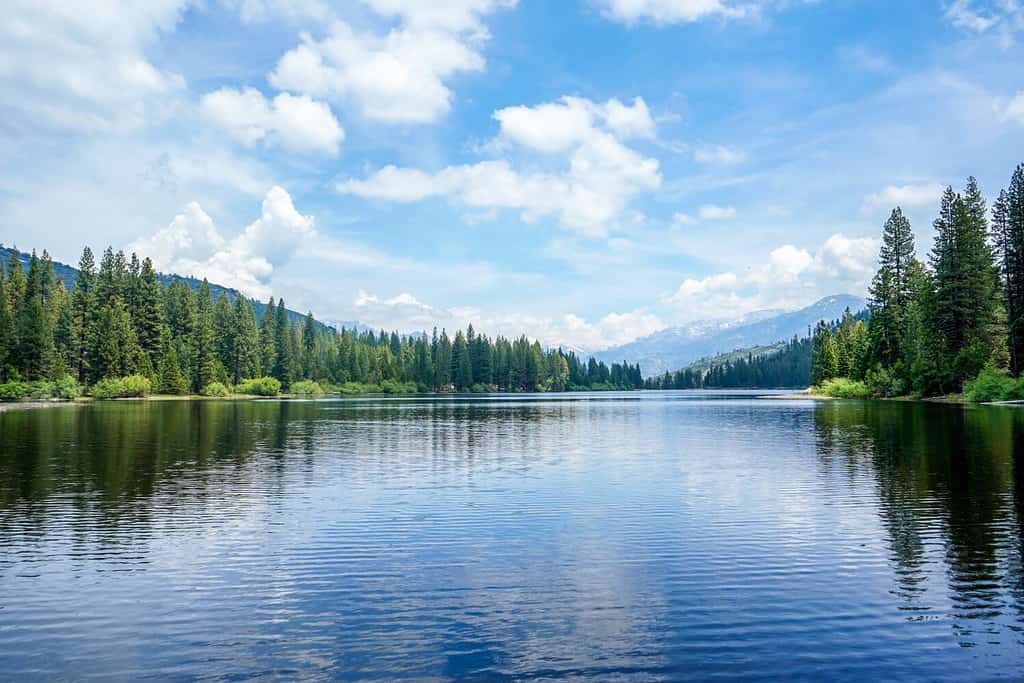
Serene waters ripple in Sequoia National Forest.
©Kathy D. Reasor/Shutterstock.com
Location
Hume Lake, situated in the Sequoia Forest off Highway 180 on the way to Kings Canyon, lies in Fresno County, California. Although the closest city is Fresno, the destination is a day trip’s drive to Bakersfield (98 miles) and Modesto (130 miles). Note: To reach Hume Lake, you must drive through the entrance station for Sequoia and Kings Canyon National Parks. This entrance requires an America the Beautiful pass or other national park pass. If you don’t own one of these passes, you can pay a $35 entrance fee which is good for seven days. Depending on the time of year, you may qualify for a reduced price.
History
This reservoir enjoys a rich, interesting origin story. In 1908, eminent dam engineer John Eastwood designed and built Hume Lake Dam, the first reinforced-concrete, multiple-arch dam in the world. Taking only three months to construct, the dam cost approximately $46,000 to build. Even for the early 20th century, this cost was surprisingly less than the typical rock-fill dams constructed during this period. The dam, created to form a log pond and water reservoir for the Hume-Bennett Lumber Company, actually used much less concrete than other dams built at the time.
The dam’s “sustainability,” however, was a bit ironic. For over a decade, the dam and lake were used to support the logging industry. Yet, in the early 1920s, the logging operations at Hume Lake ceased due to diminishing profits and a disastrous fire that claimed the original mill in 1917. In 1935, the United States Forest Service (USFS) purchased the lumber company’s holdings and property, including the dam and lake. The entire area was incorporated into Sequoia National Forest in April 1935. Since then, the dam has been subtly modified for concrete reinforcement as well as other minor improvements.
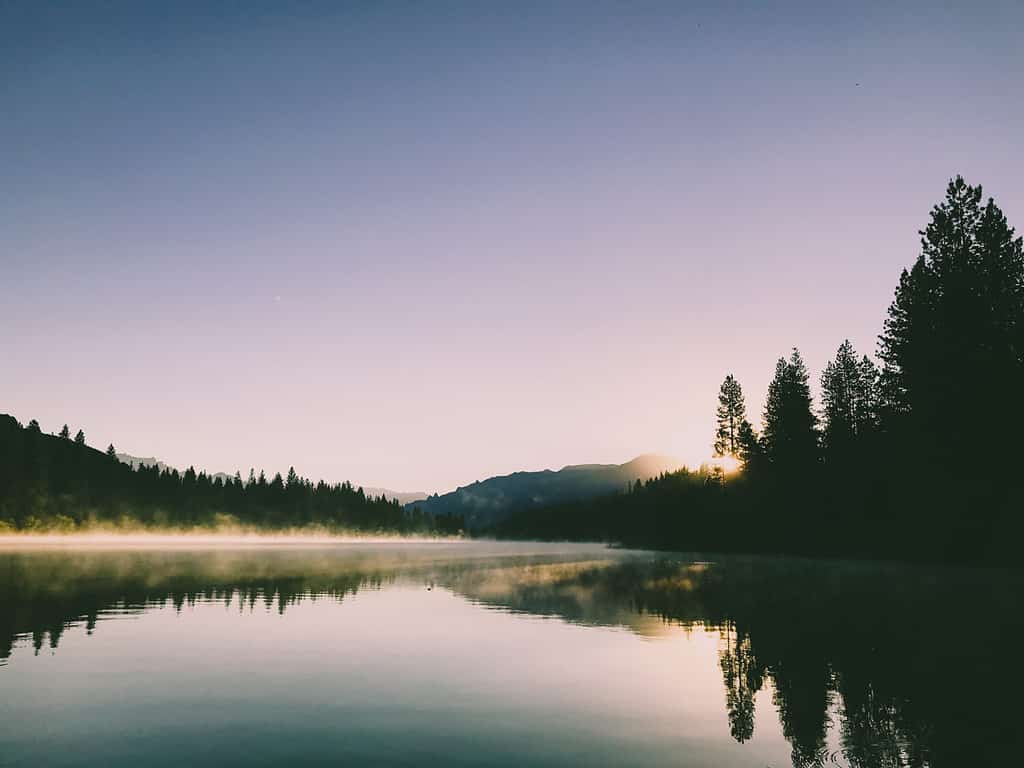
Hume Lake has a surface elevation of 5,200 feet, which is considered a moderately high altitude.
©Grant Cowan/Shutterstock.com
Size
Hume Lake has a surface area of 87 acres, making the reservoir a more intimate, smaller California water refuge. For comparison, 87 acres is approximately 90% of the size of the Mall of America in Minnesota. In contrast, Lake Tahoe has a surface area of 122,000 acres. Additionally, Hume Lake has a surface elevation of 5,200 feet, which is considered a moderately high altitude. Similarly, Denver, Colorado, also has approximately the same elevation. Tenmile Creek and Long Meadow Creek are the water’s primary inflows, with Tenmile Creek being its primary outflow.
Depth
Hume Lake’s depth is currently unavailable. However, due to the recreational activities and the types of fish caught there, it’s safe to assume that it is relatively shallow.
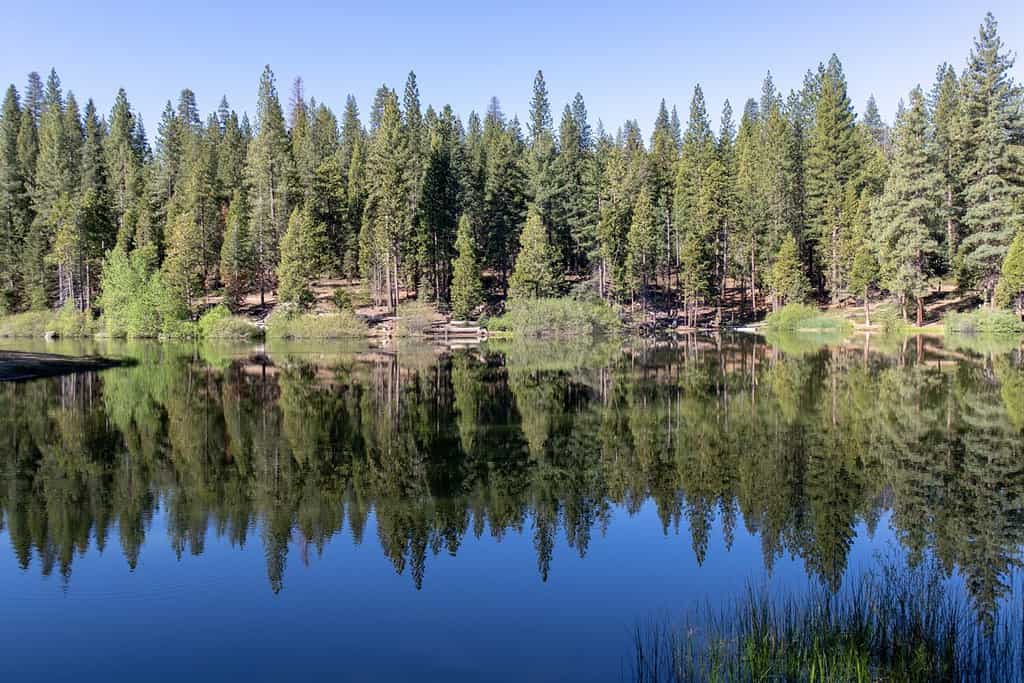
The average annual average temperature of Hume Lake is 47.3 degrees Fahrenheit.
©J Carr Photo/Shutterstock.com
Climate
Hume Lake’s climate is considered mild, with hot, dry summers and cool, wet winters. The area receives approximately 15 inches of precipitation each year, with the bulk of it during the winter months. Summer days can get extremely hot — over 100 degrees at times — but cool off considerably in the evenings. Due to its location in the Central Valley, it experiences much less humidity than other parts of California. Its average high temperature in July is 95.9 degrees Fahrenheit, about 10 degrees higher than the United States average. On the other extreme, the average low temperature in January is 33.5 degrees Fahrenheit, approximately 12 degrees higher than the United States average. The average overall yearly average temperature of Hume Lake is 47.3 Fahrenheit.
Fishing
Hume Lake is a fisherman’s paradise! Whether your goal is a big catch or some peaceful solitude, fishing here offers a myriad of opportunities.

Rainbow trout are plentiful in Hume Lake.
©Henrik A. Jonsson/Shutterstock.com
Trout
Hume Lake is home to both rainbow trout and brown trout. Rainbow trout are plentiful in the lake, but the majority of anglers in this area aren’t singling out these fish. Therefore, Hume Lake boasts an abundant amount of these fish. Rainbows here are generally 12-14 inches long, weighing three to five pounds. Brown trout also calls this sanctuary home. As brown trout like a little deeper and warmer water, the Hume Reservoir — as opposed to streams and small rivers — is a great place to fish these beautiful specimens, especially in the warmer summer months.

Hume Lake is home to a large number of bluegill.
©iStock.com/mpwoodib
Bluegill
The popular bluegill is abundant in Hume Lake. A delectable delight to eat, the Hume bluegill (especially larger fish) is better sought from a boat than the shoreline. The best times here to fish for bluegill are the hottest months of June, July, and August.
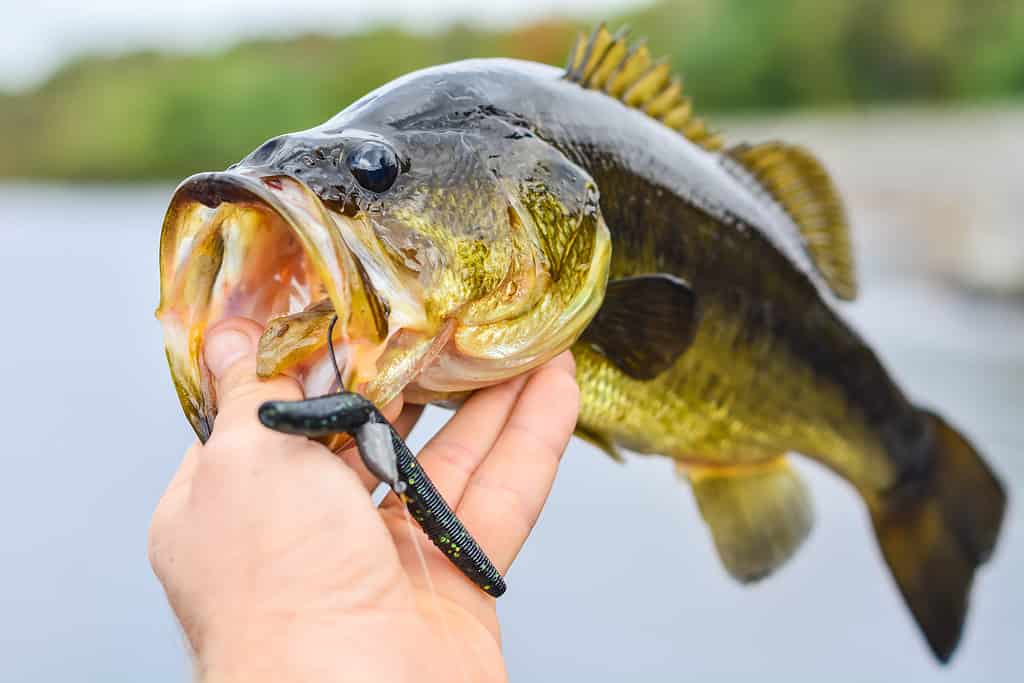
Largemouth bass, which can be found in Hume Lake, can grow over 18 inches long in three years.
©michal dziekonski/iStock / Getty Images Plus via Getty Images
Largemouth Bass
The largemouth bass is not as copious in Hume Lake as trout and bluegill, but in the southern section of the reservoir, anglers have had a certain amount of luck with these beautiful and tasty fish.

The green sunfish is a small freshwater sunfish that lives throughout the USA and northern Mexico.
©Sean McVey/Shutterstock.com
Additional Fish Species
Although trout, bass, and bluegill are Hume Lake’s staples, additional fish species exist in these waters. Anglers regularly catch green sunfish and greengill hybrid sunfish in the summer months.
Geology
The Sierra Nevada’s rock formations are mainly granitic rocks that formed in the Mesozoic Era. During this time, a chain of arc-shaped volcanoes erupted where the Sierras now stand. Molten rock erupted at the surface as lava, but most of the rock solidified. The gray granite rocks of the Sierra Nevada — clearly visible from Hume Lake — are a landmark, instantly recognizable to travelers and geological enthusiasts alike.
Boating and Other Attractions
Boating
Motorized boats aren’t allowed, making it ideal for paddlers and swimmers. On its eastern border, the lake does have a boat launch where you can put in your non-motorized canoe, kayak, skiff, jon boat, paddle boat, or inflatable. At one time, Hume Lake Christian Camps, located on the southwestern portion of the lake, rented out 10-14 foot boats, but you need to check their website before your trip.
Swimming
The summers are hot, but the water is cool at Hume Lake! Even though it’s the busiest time of the year, Hume Lake is a great locale to splash around or to float and relax. The water is fairly clear, and the further away from shore you go, the more pristine the water is.
Hiking
Sequoia National Park offers a cornucopia of hiking opportunities, including the surrounding area’s lakes and forests. Hume Lake Loop is a 2.8-mile loop that is rated as “fairly easy.” At a normal walking pace, it takes around an hour to hike the trail. With scenic views, the trail is also dog-friendly as long as your pup is on a leash.
Winter Activities
Hume Lake and the surrounding area offer plenty of recreation in the cold months, as well. Under a fresh coat of snow, the landscape is visually purified, and you can choose from snowshoeing, cross-country skiing, or just sledding and playing in the snow.
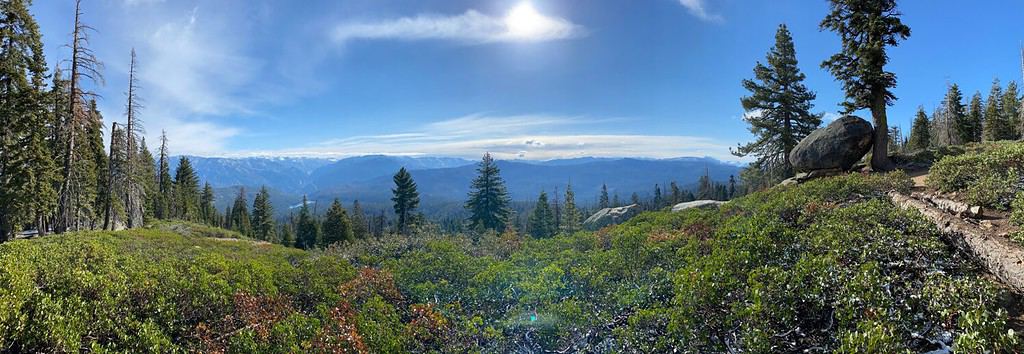
Hume Lake lies beneath a magnificent tree line in Sequoia National Forest.
©SpaceDogAir/Shutterstock.com
Camping
Finally, camping is one of the best ways to enjoy Hume Lake. As previously mentioned, Hume Lake Christian Camp offers programs for youth throughout the summer. As well, it offers a few programs in the winter months.
For the general traveler, Hume Lake Campground offers 74 campsites at $32 per night ($64 for double sites). Experts strongly recommend making reservations, which can be made up to six months in advance. Campground amenities include flush toilets, picnic tables with fire rings, bear lockers at each campsite, deadwood for starting fires, and drinkable water.
The photo featured at the top of this post is © Alexander Migl, CC BY-SA 4.0 – License / Original
Thank you for reading! Have some feedback for us? Contact the AZ Animals editorial team.







